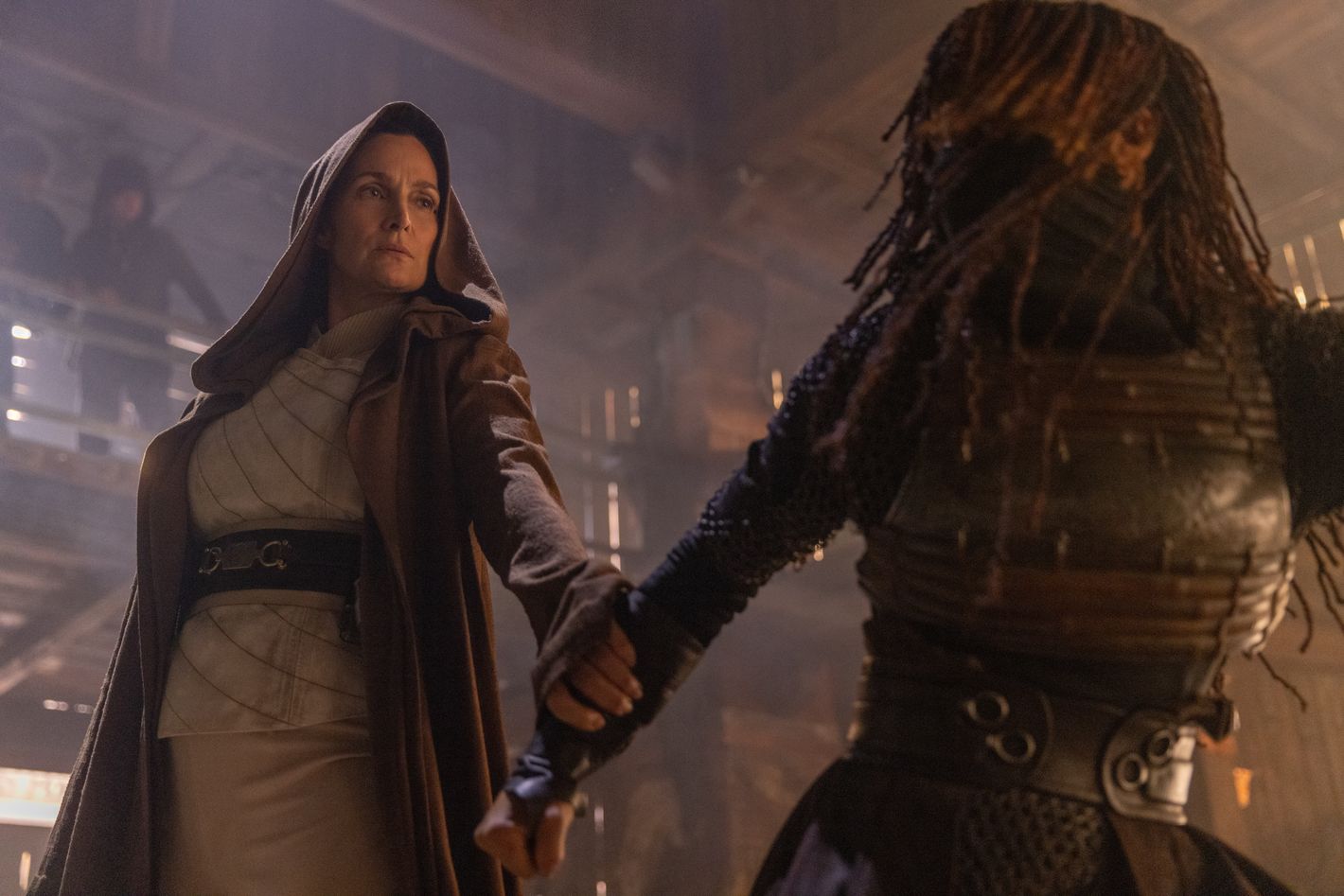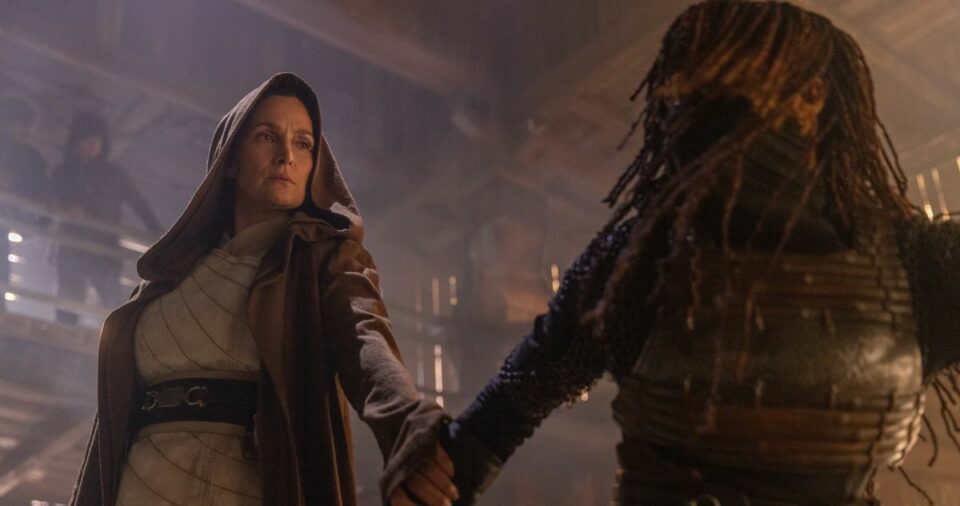
No Star Wars movie or TV show ever really begins at the beginning. For the original 1977 film, George Lucas pretended he was making the middle chapter of a long-running serial, so he didn’t bother to explain concepts like “Jedi knights,” “Clone Wars,” or “the Kessel Run.” Lucas set a precedent for this franchise that many of the writers and directors after him have tried to follow: Just jump straight into the story and go, go, go.
The Acolyte succeeds at about half of that assignment. The Star Wars TV universe’s latest series begins with a crisis already in progress, in tried and true Star Wars fashion. But I wouldn’t exactly describe the pace of this first chapter as urgent. Episode one is a solid introduction with a couple of standout moments and a sense of time and place that shows promise. But like a broken lightsaber, it lacks crackle.
Created by Leslye Headland (a playwright and filmmaker whose best-known previous TV credit was co-creator of Russian Doll), The Acolyte begins with a murder. A mysterious masked woman walks into a noodle shop and baits a Jedi master, Indara (Carrie-Anne Moss), into a fight that ends with Indara dead. The most likely suspect for the crime is Osha (Amandla Stenberg), a former Jedi in training (or Padawan) who bailed on the program because she couldn’t shake off a personal tragedy. She has since been working as an off-the-books spaceship mechanic. But even though she’s been living in deep space, Osha gets identified as the murderer by the noodle shop’s proprietor.
Enter Osha’s former teacher, Sol (Lee Jung-jae), who has a hard time believing this sweet, bruised young lady could kill anyone in cold blood. Also, has Sol ever mentioned that Osha has a twin sister, Mae?
The hunt for Osha provides the basic arc of episode one, which includes a few more key character introductions, plus one thrilling action sequence — all of which I’ll get back to. First, let’s talk about where this show sits within the larger Star Wars mythology, which — if Headland plays this right — could set it apart from The Mandalorian, Ahsoka, Andor, and the rest of the franchise’s TV projects.
One of The Acolyte’s big hooks is that it reaches back further in the Star Wars timeline than any live-action movie or TV series has. (The cartoons, books, comics, and games, however, have jumped all across the timeline.) The opening text tells us we’re starting about 100 years before the rise of the Empire as depicted in the prequel trilogy (The Phantom Menace, Attack of the Clones, and Revenge of the Sith). This is the era known in Star Wars lore as the High Republic: The galaxy is mostly at peace, governed by trade federations and the quasi-religious, quasi-militaristic order of Jedi knights, with a lot of labor provided by the hyperintelligent robots called droids.
But stability can bring complacency, which seems to be a big part of what The Acolyte is about. There’s a cockiness to the Jedi in this era, seen early in this episode when the swaggering Yord (Charlie Barnett) arrives on a starship to question Osha and immediately starts barking orders at citizens, capping things off with a curt “Thank you for your cooperation.” Later, on the primary administrative planet of Coruscant, the Jedi pooh-bah Vernestra (Rebecca Henderson) strides with authority into Sol’s classroom — with an imperious hand wave, using the mystical power of the Force just to open a dang door — and tells him Osha needs to be brought to justice as swiftly as possible to set an example.
Clearly, there’s already some concern within the Jedi Order about its reputation and standing. In fact, in that same opening text that describes how “the Jedi Order and the Galactic Republic have prospered for centuries without war,” we are warned, “But in the dark corners of the galaxy, a powerful few learn to use the Force in secret.”
Which brings us back to that opening scene where the cloaked assassin — who is in fact Mae (also played by Stenberg) — tells Master Indara, “We have unfinished business. Attack me with all your strength.” When Indara tells this “unidentified Force user” that the Jedi do not attack the unarmed, Mae replies, “Yes, you do.” Then, after some intense hand-to-hand and lightsaber-to-knife combat, Mae flings a blade deep into Indara’s chest. Someone out there has a grudge against the Jedi, and Mae has become their instrument of retribution.
As I mentioned, The Acolyte’s series premiere could be a lot snappier. At just over 40 minutes, it doesn’t wear out its welcome, but it does tend to follow the lead of its ostensible hero, Sol, who is by nature muted. Lee (an Emmy winner for his starring role in Squid Game) has charisma and handles an English-speaking part quite well. But the energy around him is — for now, at least — a bit too low-key for an action-adventure saga.
That said, the opening standoff between Indara and Mae is genuinely exciting. It establishes something about The Acolyte that Headland has mentioned in interviews promoting the show: that she intends to feed off Lucas’s original nods to Japanese and Hong Kong cinema in the 1977 Star Wars. Expect a little chanbara and wuxia, in other words.
Osha’s accidental jailbreak is an even better set-piece. While on a transport back to Coruscant, one of Osha’s fellow prisoners uses an electronic/mental link to disable the droid pilots. They downshift out of hyperspace — in the middle of an asteroid field, of course, because this is a Star Wars story — and scramble to the escape pods, leaving Osha behind because she refused to help them. (Despite her current predicament, she insists, “I have faith in the Jedi.”)
This whole sequence is well staged, filled with imminent danger and surprising twists. As the ship careers out of control, Osha reaches beyond the bars of her prison for her pocket-size personal droid assistant, Pip. For a moment, it looks as if she might use the Force to telekinetically pull Pip into her hand, but either she can’t or she won’t and has to wait for Pip to slide into reach. Then, as she’s about to jump into the last remaining escape pod, Osha stops to free the one criminal left onboard … only for him to push past her and take the pod himself.
This is all fun to watch, and it serves a narrative purpose. The episode withholds the big “oh, Osha has a twin” twist for a good long while, which means at first we have no reason to believe Osha when she says she had nothing to do with Indara’s murder. In fact, the first time we meet her — right after we’ve just seen her look-alike sister commit the crime — she refuses to tell her co-worker what she’s been doing on her days off. So seeing her later risk her own life to assist someone else helps to establish that she is — probably — on the right side.
Sol, though, doesn’t need a lot of convincing to have faith in Osha. He remembers her too well as a scared 8-year-old — too old, really, to have been admitted into the Padawan program. He stares wistfully at old holographic images of her, which troubles his current Padawan Jecki (Dafne Keen) because Jedi masters aren’t supposed to be so sentimental. Yet Sol’s feelings ultimately come in handy when Vernestra agrees to send him, Yord, and Jecki to the planet Carlac, where Osha has crash-landed. They find her there — and rescue her from a near-fatal fall — not long after she’s had a vision of Mae and realizes that the sister she has long assumed was dead is alive.
The episode closes on Mae’s meeting up with a dark, distant figure wielding a lightsaber. This ominous someone proceeds to deliver a thesis statement for The Acolyte, saying, “The Jedi live in a dream. A dream they believe everyone shares. If you attack a Jedi with a weapon, you will fail. Steel or laser are no threat to them. But an acolyte? An acolyte kills without a weapon. An acolyte kills the dream.”
There is a story behind this statement, no doubt — and it promises to be a good one. Here’s hoping that, going forward, The Acolyte can get to it a little quicker.
Force Ghosts
• Can I just say how much I love the Star Wars logo and music that opens every episode of the franchise’s TV series? Marvel and Star Trek have similar tags before each of their shows, but I think Star Wars has the best one.
• I dig the design of the restaurant Mae walks into at the start of the episode. The big, open first floor, ringed by a set of tables on the second floor, looks very much like the kind of eating-and-drinking establishment you’d see in a kung fu movie (and in Kill Bill, one of Headland’s reported inspirations for The Acolyte).
• Unlike in Andor — which pushes the boundaries of how a Star Wars story should look and feel — Headland seems to be staying pretty traditional with the style of this show. The screen is filled with odd-looking alien creatures of every shape, size, texture, and hue, and to transition between scenes, Headland employs the classic Star Wars wipes. Hey, if it works, it works!
• In Sol’s classroom, he asks his Padawans to connect to the Force and describe what they find there. One says, “Balance.” Another says, “Life.” And a third sees an all-consuming fire. Uh-oh.
Noel Murray , 2024-06-05 04:00:08
Source link


